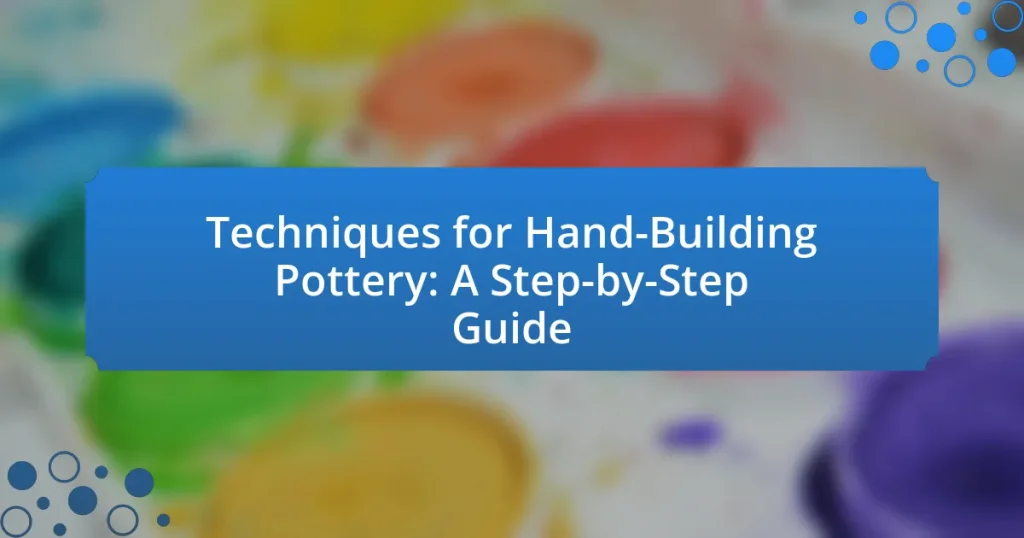The article focuses on the fundamental techniques for hand-building pottery, specifically the pinch, coil, and slab methods. It provides a detailed overview of each technique, including step-by-step processes for creating pinch pots, coil pots, and slab pottery, along with essential tools and materials needed for hand-building. The article also discusses the significance of hand-building in pottery, its advantages over wheel throwing, and best practices for workspace preparation and firing. Additionally, it highlights finishing techniques and surface decoration methods that enhance the final appearance of hand-built pottery.

What are the fundamental techniques for hand-building pottery?
The fundamental techniques for hand-building pottery include pinch, coil, and slab methods. The pinch technique involves shaping clay by pinching it between fingers to create forms, which is one of the oldest pottery techniques. The coil method consists of rolling out long strands of clay and stacking them to build up walls, allowing for more complex shapes. The slab technique involves rolling out flat pieces of clay and joining them together to form structures, which is effective for creating geometric designs. Each technique has been used for thousands of years, with archaeological evidence showing their application in various ancient cultures, confirming their significance in pottery-making.
How do different hand-building methods compare?
Different hand-building methods, such as pinch, coil, and slab construction, vary in technique and application. Pinch method involves shaping clay by pinching it with fingers, allowing for organic forms and small pieces. Coil method uses rolled clay strips stacked and blended together, ideal for larger, more sculptural works. Slab construction involves rolling out flat pieces of clay to create geometric shapes, suitable for functional items like plates and boxes. Each method offers unique aesthetic and structural qualities, catering to different artistic intentions and skill levels.
What is pinch pottery and how is it created?
Pinch pottery is a hand-building technique used to create ceramic forms by pinching and shaping clay with the fingers. This method involves taking a ball of clay, pressing a thumb into its center to create a hollow space, and then using the fingers to pinch and manipulate the walls of the vessel to achieve the desired shape and thickness. The technique is one of the oldest forms of pottery-making, dating back to prehistoric times, and is valued for its simplicity and the unique, organic shapes it produces.
What is coil pottery and what are its steps?
Coil pottery is a hand-building technique in ceramics where long rolls of clay, or coils, are stacked and joined to create a vessel or sculpture. The steps involved in coil pottery include:
- Preparing the clay by wedging it to remove air bubbles and achieve a uniform consistency.
- Rolling out coils of clay to the desired thickness, typically around 1/4 inch.
- Stacking the coils on top of each other to form the shape of the piece, ensuring to blend the seams for structural integrity.
- Shaping the vessel by pinching, smoothing, or adding additional coils as needed.
- Allowing the piece to dry to a leather-hard state before refining the shape and surface.
- Bisque firing the piece in a kiln to harden it.
- Glazing the pottery and performing a glaze firing to finish the piece.
This method has been used for thousands of years, with evidence of coil pottery dating back to ancient cultures, demonstrating its historical significance in ceramic art.
What is slab pottery and how is it constructed?
Slab pottery is a hand-building technique in ceramics that involves shaping flat pieces of clay into various forms. To construct slab pottery, artisans roll out clay into even sheets, cut these sheets into desired shapes, and then join them together using scoring and slip to create three-dimensional objects. This method allows for greater control over the design and texture of the pottery, making it a popular choice for both functional and artistic pieces.
Why is hand-building an essential skill in pottery?
Hand-building is an essential skill in pottery because it allows artists to create unique forms and structures without relying on a potter’s wheel. This technique fosters creativity and individual expression, enabling potters to manipulate clay in diverse ways, such as coiling, pinching, and slab building. Historical evidence shows that hand-building techniques date back thousands of years, with ancient cultures using them to produce functional and decorative pottery, thus establishing their significance in the craft.
What advantages does hand-building offer over wheel throwing?
Hand-building offers greater creative freedom compared to wheel throwing. This technique allows artists to manipulate clay in various ways, such as pinching, coiling, and slab building, enabling the creation of unique shapes and textures that may not be achievable on a wheel. Additionally, hand-building is more accessible for beginners, as it does not require the same level of skill and practice needed for wheel throwing. Studies indicate that hand-building can also foster a deeper connection between the artist and the material, as it encourages tactile engagement and experimentation.
How does hand-building enhance creativity in pottery making?
Hand-building enhances creativity in pottery making by allowing artists to manipulate clay freely without the constraints of a wheel. This technique encourages individual expression through various methods such as pinching, coiling, and slab building, which enable potters to create unique forms and textures. Research indicates that hand-building fosters a deeper connection between the artist and the material, as it requires tactile engagement and personal decision-making throughout the process. This hands-on approach not only cultivates innovative designs but also promotes problem-solving skills, as potters must adapt their techniques to achieve desired outcomes.

What materials and tools are needed for hand-building pottery?
To hand-build pottery, essential materials include clay, water, and tools such as a rolling pin, rib, and sculpting tools. Clay serves as the primary medium for shaping, while water is necessary for maintaining moisture and workability. The rolling pin is used to flatten the clay, the rib helps smooth surfaces, and sculpting tools assist in detailing and shaping the pottery. These tools and materials are fundamental for creating various forms and designs in hand-built pottery.
What types of clay are best for hand-building techniques?
The best types of clay for hand-building techniques are earthenware, stoneware, and porcelain. Earthenware is ideal for beginners due to its plasticity and ease of use, allowing for detailed shaping and texturing. Stoneware, known for its durability and versatility, can be used for both functional and artistic pieces, making it suitable for a variety of hand-building projects. Porcelain, while more challenging to work with, offers a fine texture and translucency, making it perfect for intricate designs. Each type of clay has unique properties that cater to different hand-building needs, ensuring that artists can choose the right material for their specific projects.
How do different clay bodies affect the hand-building process?
Different clay bodies significantly influence the hand-building process by affecting workability, drying time, and final texture. For instance, earthenware clay is more pliable and easier to shape, making it suitable for beginners, while stoneware clay offers greater durability but requires more effort to manipulate. Additionally, the moisture content in various clay bodies impacts drying times; for example, porcelain dries more quickly than earthenware, which can lead to cracking if not managed properly. The final texture also varies; grogged clay bodies provide a rougher surface that can enhance grip during construction, while smoother clays allow for finer detailing. These characteristics dictate the techniques and tools used during hand-building, ultimately shaping the outcome of the pottery.
What are the essential tools for hand-building pottery?
The essential tools for hand-building pottery include a pottery wheel, various types of clay, hand tools like rib tools, wire cutters, and sponges. A pottery wheel is crucial for shaping and forming the clay, while different types of clay, such as earthenware or stoneware, provide the necessary material for creating pottery. Hand tools, including rib tools for smoothing surfaces, wire cutters for cutting clay, and sponges for adding moisture and texture, enhance the hand-building process. These tools are fundamental for achieving precision and creativity in pottery-making.
How can one prepare the workspace for hand-building pottery?
To prepare the workspace for hand-building pottery, one should ensure a clean, flat surface that is free from debris and dust. This involves clearing the area of any unnecessary items, wiping down surfaces with a damp cloth, and covering the workspace with a canvas or plastic sheet to protect it from clay residue. Additionally, having essential tools such as a rolling pin, rib, and water container readily available enhances efficiency. Proper lighting is also crucial, as it allows for better visibility of details during the hand-building process. These steps create an organized and functional environment conducive to successful pottery creation.
What are the best practices for setting up a pottery workspace?
The best practices for setting up a pottery workspace include ensuring adequate space, proper ventilation, and organized tools. A spacious area allows for movement and creativity, while ventilation is crucial for safety when working with clay and glazes that may emit harmful fumes. Organizing tools such as sculpting tools, sponges, and clay in accessible storage helps streamline the pottery-making process. Additionally, having a sturdy work surface, such as a table or a dedicated pottery wheel, enhances stability and efficiency during hand-building techniques. These practices are supported by pottery experts who emphasize the importance of a functional and safe workspace for optimal creativity and productivity.
How does workspace organization impact the hand-building process?
Workspace organization significantly enhances the hand-building process by improving efficiency and reducing errors. A well-organized workspace allows potters to easily access tools, materials, and resources, which streamlines the workflow and minimizes interruptions. For instance, having tools within reach and materials sorted by type can save time and prevent frustration, leading to a more focused and productive hand-building experience. Studies in craft and design emphasize that an orderly environment fosters creativity and concentration, which are crucial for intricate hand-building techniques.

What are the step-by-step processes for each hand-building technique?
The step-by-step processes for each hand-building technique in pottery include pinch, coil, and slab methods.
-
Pinch Method:
- Start with a ball of clay.
- Use your thumb to create an indentation in the center.
- Pinch the walls of the clay outward while rotating it to form a vessel shape.
- Smooth the surface as needed.
-
Coil Method:
- Roll out long, thin coils of clay.
- Stack the coils on top of each other to build the desired shape.
- Blend the coils together by smoothing the joints with fingers or tools.
- Refine the shape and surface texture.
-
Slab Method:
- Roll out a flat slab of clay using a rolling pin.
- Cut the slab into desired shapes using a knife or clay cutter.
- Assemble the pieces by scoring and slipping the edges to join them.
- Smooth the seams and refine the overall form.
These techniques are foundational in hand-building pottery, allowing for creativity and structural integrity in the final pieces.
How do you create a pinch pot from start to finish?
To create a pinch pot from start to finish, begin by taking a ball of clay, typically about the size of a fist. Next, shape the clay into a smooth sphere, ensuring there are no cracks or air bubbles. Then, press your thumb into the center of the sphere to create an indentation, while keeping the walls of the pot thick enough to maintain structure. Gradually pinch the walls of the pot with your fingers, rotating the pot as you work to create an even thickness. Continue pinching and shaping until the pot reaches the desired height and form. Finally, smooth the surface with a damp sponge or cloth, and allow the pot to dry before firing it in a kiln. This method is a fundamental technique in hand-building pottery, emphasizing tactile engagement with the material.
What are the key steps in forming and finishing a pinch pot?
The key steps in forming and finishing a pinch pot include creating a ball of clay, pinching the clay to form the desired shape, smoothing the surface, and applying any decorative elements before firing. First, start with a ball of clay, typically about the size of a fist. Next, use your thumb to create an indentation in the center of the ball, then pinch the walls of the pot evenly while rotating it to maintain a consistent thickness. After achieving the desired shape, smooth the surface with your fingers or a damp sponge to eliminate any rough spots. Finally, add decorative elements such as textures or patterns, and allow the pot to dry before firing it in a kiln. These steps are fundamental in hand-building pottery, ensuring a well-formed and finished pinch pot.
What common mistakes should be avoided when making pinch pots?
Common mistakes to avoid when making pinch pots include uneven wall thickness, which can lead to cracking during drying or firing. Ensuring consistent thickness throughout the pot is crucial for structural integrity. Another mistake is not properly blending the seams where the fingers pinch the clay, resulting in weak points that may break. Additionally, neglecting to keep the clay moist can cause it to dry out too quickly, making it difficult to shape. Lastly, failing to smooth the surface can lead to an unrefined appearance and potential weak spots. These mistakes can significantly affect the quality and durability of the finished piece.
What is the process for making coil pots?
The process for making coil pots involves several key steps. First, gather clay and prepare it by wedging to remove air bubbles and ensure uniform consistency. Next, roll out long, even coils of clay, typically about the thickness of a finger. Then, begin constructing the pot by stacking the coils on top of each other, smoothing the joints with fingers or tools to create a seamless surface. As the pot rises, shape it by pinching or using tools to refine the form. Finally, allow the pot to dry to a leather-hard state before trimming and adding any decorative elements, followed by bisque firing and glazing. This method has been used for thousands of years, with evidence of coil pottery dating back to ancient civilizations, demonstrating its historical significance and effectiveness in pottery making.
How do you build and shape a coil pot effectively?
To build and shape a coil pot effectively, start by rolling out even coils of clay, ensuring they are uniform in thickness, typically around half an inch. Next, stack the coils on top of each other, gently pressing them together to eliminate air pockets and create a solid bond. As you build upward, use your fingers or a tool to smooth the joints between coils, shaping the pot’s walls to your desired height and contour. This technique allows for gradual shaping and refinement of the pot’s form. The effectiveness of this method is supported by traditional pottery practices, where coil building has been used for thousands of years, demonstrating its reliability in creating durable and aesthetically pleasing pottery.
What techniques can enhance the design of coil pots?
Techniques that can enhance the design of coil pots include the use of varied coil thickness, surface texture application, and incorporation of decorative elements. Varying coil thickness allows for unique shapes and structural integrity, while applying different surface textures, such as carving or stamping, adds visual interest and tactile quality. Additionally, incorporating decorative elements like handles, lids, or embellishments can elevate the overall aesthetic and functionality of the coil pot. These techniques are widely recognized in pottery practices, as they contribute to both the artistic expression and practical use of the finished piece.
What are the steps involved in slab pottery creation?
The steps involved in slab pottery creation include preparing the clay, rolling out the slabs, cutting and shaping the slabs, assembling the pieces, drying, and firing the pottery. First, the clay must be wedged to remove air bubbles and achieve a consistent texture. Next, the clay is rolled out into flat slabs using a rolling pin or slab roller, ensuring uniform thickness. After that, the slabs are cut into desired shapes using a knife or template. The cut pieces are then assembled, often using slip as an adhesive, to create the final form. Once assembled, the pottery must dry slowly to avoid cracking, followed by bisque firing in a kiln to harden the clay. Finally, the pottery can be glazed and fired again to complete the process. Each step is crucial for achieving a successful slab pottery piece.
How do you roll out and cut slabs for pottery?
To roll out and cut slabs for pottery, first prepare a clean, flat surface and gather your clay, rolling pin, and a cutting tool. Begin by kneading the clay to remove air bubbles, then place it between two slats of wood or use a thickness guide to ensure uniformity. Roll the clay evenly with the rolling pin until it reaches the desired thickness, typically around 1/4 inch. Once rolled out, use a cutting tool, such as a knife or a clay cutter, to cut the slab into the desired shapes or sizes. This method ensures that the slabs are consistent in thickness and shape, which is crucial for successful hand-building pottery.
What methods can be used to join slabs together securely?
To join slabs together securely in hand-building pottery, methods such as scoring and slipping, using coils, and applying pressure are effective. Scoring involves scratching the edges of the slabs to create a rough surface, which increases adhesion when slip, a mixture of clay and water, is applied. Coils can be added to the joints for additional support, while applying pressure ensures a tight bond between the slabs. These techniques are widely recognized in pottery practices, as they enhance the structural integrity of the assembled pieces.

What finishing techniques can enhance hand-built pottery?
Finishing techniques that can enhance hand-built pottery include smoothing, burnishing, glazing, and applying underglazes. Smoothing involves refining the surface with tools or fingers to eliminate imperfections, which can improve the aesthetic quality of the piece. Burnishing, a technique that involves rubbing the surface with a smooth object, creates a polished finish and enhances the clay’s natural color. Glazing adds a layer of color and a protective coating, making the pottery functional and visually appealing. Applying underglazes allows for intricate designs and patterns before the final glaze is applied, providing depth and detail to the artwork. Each of these techniques contributes to the overall quality and visual impact of hand-built pottery.
How can surface decoration be applied to hand-built pottery?
Surface decoration can be applied to hand-built pottery through techniques such as slip trailing, sgraffito, and underglazing. Slip trailing involves applying a liquid clay mixture (slip) onto the surface to create raised designs, while sgraffito entails scratching through a layer of slip to reveal the clay body underneath, allowing for intricate patterns. Underglazing involves painting designs on the pottery before glazing, ensuring that the decoration remains visible after firing. These methods are widely used in pottery to enhance aesthetic appeal and can be adapted to various styles and personal preferences.
What types of glazes are suitable for hand-built pieces?
Suitable glazes for hand-built pieces include earthenware glazes, stoneware glazes, and porcelain glazes. Earthenware glazes are often used for their vibrant colors and lower firing temperatures, making them ideal for hand-built pottery. Stoneware glazes provide durability and a range of finishes, suitable for functional ware. Porcelain glazes, known for their translucency and smooth finish, are also appropriate for hand-built porcelain pieces. These glazes are compatible with the clay bodies typically used in hand-building, ensuring proper adhesion and aesthetic appeal.
How does texture affect the final appearance of pottery?
Texture significantly influences the final appearance of pottery by altering its visual and tactile qualities. Different textures can create contrasts in light reflection, enhance the depth of color, and contribute to the overall aesthetic appeal of the piece. For instance, a smooth surface may convey elegance and simplicity, while a rough or patterned texture can evoke a sense of rustic charm or complexity. Additionally, textures can affect how glazes interact with the surface; textured pottery often showcases glazes differently, leading to unique finishes that highlight the craftsmanship involved. This relationship between texture and appearance is well-documented in pottery studies, emphasizing that the choice of texture is a critical aspect of the artistic expression in ceramic art.
What are the best practices for firing hand-built pottery?
The best practices for firing hand-built pottery include ensuring proper drying, selecting the right kiln, and controlling the firing temperature. Proper drying prevents cracking and warping; pieces should be dried slowly and evenly to avoid stress. Using a kiln suited for the clay type, such as an electric or gas kiln, ensures optimal results. Additionally, firing temperatures should align with the clay’s specifications, typically ranging from cone 06 (around 1830°F) for earthenware to cone 10 (around 2381°F) for stoneware. Following these practices enhances the durability and aesthetic quality of the pottery.
How does the firing process differ for various clay types?
The firing process differs for various clay types primarily in temperature and duration. Earthenware typically fires at lower temperatures, around 1,830°F (1,000°C), resulting in a porous and less durable product. Stoneware, on the other hand, requires higher firing temperatures, approximately 2,192°F (1,200°C), which vitrifies the clay, making it denser and more durable. Porcelain, the highest firing clay, reaches temperatures of about 2,372°F (1,300°C), resulting in a translucent and strong final product. These differences are crucial as they affect the clay’s final properties, such as strength, porosity, and aesthetic qualities.
What precautions should be taken during the firing process?
During the firing process, it is essential to ensure proper ventilation to prevent the buildup of harmful gases. Adequate airflow reduces the risk of toxic fumes, which can be emitted from certain clay bodies and glazes when heated. Additionally, monitoring the kiln temperature is crucial; using a reliable pyrometer helps maintain the correct firing schedule, preventing over-firing or under-firing, which can compromise the integrity of the pottery. Furthermore, wearing appropriate personal protective equipment, such as heat-resistant gloves and safety goggles, protects against burns and eye injuries during loading and unloading the kiln. These precautions are vital for ensuring safety and achieving optimal results in pottery firing.
What tips can help improve hand-building pottery skills?
To improve hand-building pottery skills, practice consistently and focus on mastering basic techniques such as pinch, coil, and slab methods. Regular practice allows for muscle memory development, which enhances control and precision in shaping clay. Additionally, studying the work of experienced potters can provide insights into effective techniques and styles. Engaging in workshops or classes can also offer hands-on guidance and feedback, further accelerating skill development.
How can practice and experimentation enhance hand-building techniques?
Practice and experimentation enhance hand-building techniques by allowing artisans to refine their skills and discover innovative methods. Regular practice leads to improved muscle memory and control, which are essential for manipulating clay effectively. Experimentation encourages the exploration of different materials, tools, and techniques, fostering creativity and adaptability. For instance, a study published in the Journal of Craft Research highlights that potters who engage in varied experimental practices develop a deeper understanding of clay properties, resulting in more sophisticated and unique creations. This combination of consistent practice and creative experimentation ultimately elevates the quality and diversity of hand-built pottery.
What resources are available for learning more about hand-building pottery?
Books, online courses, and community workshops are valuable resources for learning about hand-building pottery. Notable books include “The Complete Guide to Handbuilding” by John Britt, which provides comprehensive techniques and projects. Online platforms like Skillshare and Udemy offer structured courses that cover various hand-building methods, often taught by experienced potters. Additionally, local art centers and pottery studios frequently host workshops, allowing hands-on experience and direct guidance from instructors. These resources collectively enhance understanding and skills in hand-building pottery.


